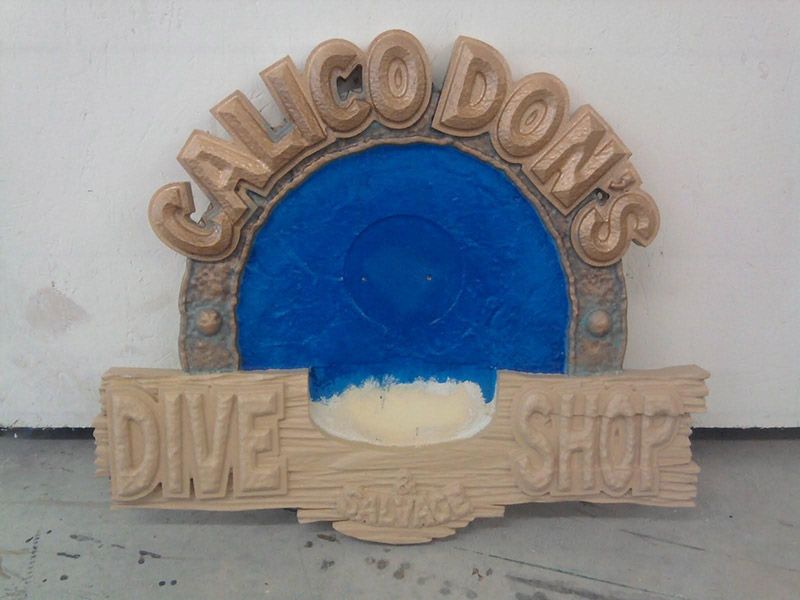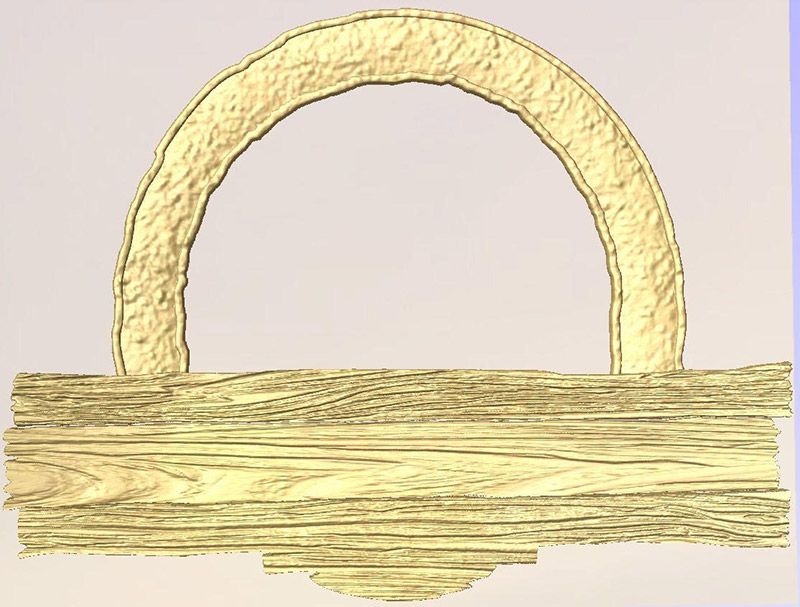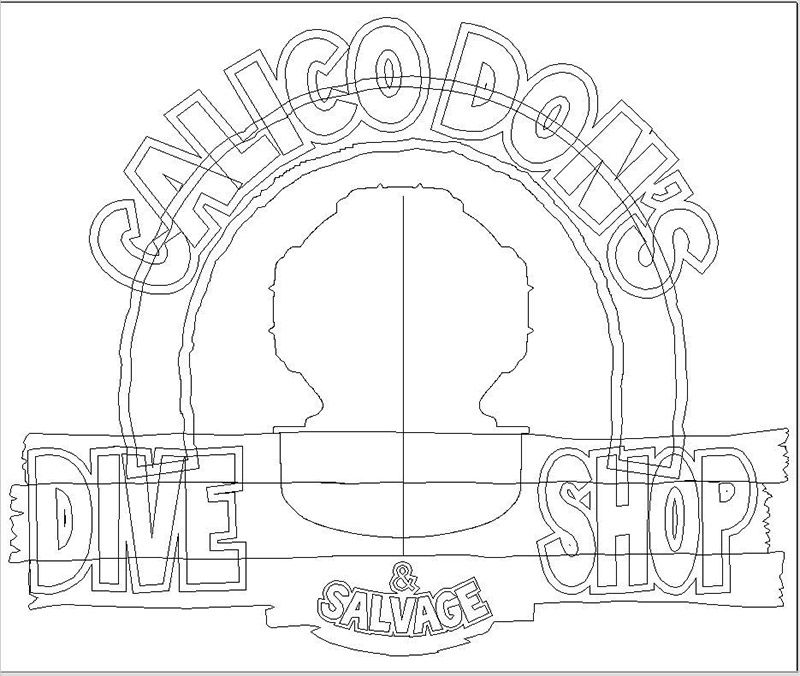
Jamie Oxenham, founder of Oxenham Design has over 20 years experience in the design and fabrication industry. After deciding to setup his own business 5 years ago he now supplies the film, television, print and entertainment markets with a variety of services including CNC fabrication, styrofoam fabrication, casting, mold-making and 2D and 3D design.
Jamie admits that it wasn't easy when starting out. Despite previous experience in the film industry it still took a lot of perserverance and focus for his efforts to pay off. Eventually word of mouth spread about the quality of his work which saw one job lead to another, it was during ones of these contracts that Jamie was exposed to the world of CNC.
Jamie kindly agreed to tell us more about how he got into using CNC and his use of Vectric's Aspire software to help him complete a recent sign project...
"It wasn't long after I setup my business that I was exposed to a colleague's HAAS VMC CNC machine. This was amazing to me. I knew very little about CNC and never really had that much interest in it, until then. Because I had learned to build everything 'old school' I could see first hand how much time you could save using CNC - I was hooked. I spent a long time looking for a used router that would suit my zero dollars budget, and after some time I found an old chain and cable driven Camtech machine for sale (oh, how I loved replacing the cables all the time) but it did the job.
The learning curve for me on the machine was quite fast, I had the router doing what I intended it to do in the first weekend and the very first job I landed paid for the machine. However, the software side was a huge learning curve. The computer for the CNC came with a copy of a well known art based routing software installed on it. Vectric's Aspire wasn't available then so this is what I started out using. As time progressed, the other software became too expensive for me to keep up with, and it was around then that I found out that Aspire version 1 was available, this was it! It was so much more affordable and had a fast growing community on the Vectric forum. At the time many of the forum users were also learning about the software just like me, yet everyone helped everyone as best as they could. It really felt like a great community that has only grown better over the years. I also use Cut3D as it speeds up some of the time it takes to get a 3D part made.
After the learning curve in both machinery and software, we are now using Techno CNC routers, which have been a huge help in getting us to where we are. As a dynamic duo, I feel that Techno CNC, coupled with our CNC software choice, Aspire, account for 80% of our finished products and make our everyday work so much easier and faster than any other combo. When dealing with production companies that have last minute deadlines, you can't afford equipment that doesn't work right all the time, for example, when you need a 10 foot Himalayan Yeti, covered in fur, in 3 days, there is no time for software that isn't intuitive, and hardware that doesn't listen very well! Not all jobs have ridiculou-silly deadlines however."
Since the introduction of CNC, Oxenham Design are rapidly moving into the themed dimensional signage market for when the film and television industry has its slow periods. Jamie continues...
"Having Aspire makes the addition of themed signage an easy move for us. For the Dive Shop sign, I started with a sketch (left) that would serve as a solid foundation for the look of the sign which I imported as a basis for drawing all the vectors (below). I would then use these to build the individual components. Once I was happy with the overall look, I had 3 separate sections I needed to make: the sign backer, the helmet and the crab. In this instance I used our sub-d modeling program to generate the helmet portion (this is where Aspire's versatility shines as it plays very well with ALL of our other design software). The sign backer was then created using Aspire.
The thing that makes this style of sign stand out is the extreme use of textures (below). Every component has one form of texture or another applied to it.
The use of textures turns the job into a time versus results process. For a small general texture, this is done faster with a heavy bodied primer. For more extreme textures like the mottled brass hoop and rivets, and the wood-grain, bitmap images were used. It's safe to say that I've amassed quite a texture collection to date. For the wood planks I drew them as 3 separate boards so I could vary the heights and profiles to make them look like they had split away from each other over time. The trick was to imagine what a great sign design would have looked like years ago, and then add the effects of time to it. One of the most frequently used tools in Aspire for this was the 'create vector boundary' tool. When the helmet was imported, this tool gave me a vector outline that I could use to meld the helmet into the sign for a well fitted look.
With Aspire, I was able to machine the helmet front and back, so it would have undercuts, making it read on the sign as a separate piece. This also got a mottled texture that we would paint so that it would look like heavily corroded brass, after all, this sign would be by the ocean. I also machined the portholes separately, making it look like individual pieces. This also made it faster and easier to apply the texture to the helmet portion. All of these details add to the depth of the sign which looks better to me than if I had just cut one big lump of a model with no undercuts. A little extra time at this stage makes for a finished piece that looks better than other 'bas relief' signs that seem to be the norm. When it was time for the painting, it was pretty straight forward. We started with the base colors, then applied multiple coats of paint and glaze mixed together. The glaze fills in all the bits of texture, and when partially wiped off, exposes the already dry base colors. This is the reason for all the texture we took the time to add. The crab (below) was completely hand sculpted from epoxy putty with metal armatures embedded for strength.
I couldn't imagine a single day at the shop that didn't involve Aspire. Not everything we do is 3D machined, in fact we do a lot of 2D machining as well. But whatever the job may be, you can bet Aspire was involved in part or in full."
Following the Dive Shop Sign, Oxenham design are working on a Davinci inspired airplane for a small movie. With a deadline of just 2 weeks, Jamie is confident that this is a good time frame to create a 17 foot plane with a 25' wingspan. Aspire has been used to create all the toolpathing for this project, and almost all the vector work as well, with the propeller due to be machined using Cut3D due to its ease of use for this kind of model. Following our discussion we asked Jamie what's next for Oxenham Design...
"As far as the future goes we will always continue with the props we make, but we are definitely going to be moving into themed dimensional signage. If I could evenly split my year between teaching the software, fabricating props, dimensional signage, and design work, I will be quite happy. Life is very exciting when you have no idea what will come through the door next. Rumor has it, it might be a remote control 1/2 scale truck, or it might not be ;)"
You can follow the production of all the exciting projects Oxenham Designs are creating (and have created) over on their blog - www.fromaspiretobeyond.blogspot.com or you can learn more about the company via their website www.oxenhamdesign.com. Vectric will be working with Jamie again soon to discuss the production of a variety of his popular pieces, so look out for a continuation of this case study in the near future.





Vectric Ltd
Precision House
2 Arden Road
Alcester
B49 6HN
Registered in England Number 05382596
VAT Registration GB115123072
Privacy Policy |
Cookie Policy |
Terms and Conditions